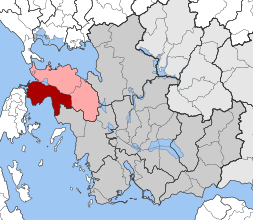Palairos
| Palairos Πάλαιρος | |
|---|---|
|
Paleros municipal unit | |
 Palairos | |
|
Location within the regional unit  | |
| Coordinates: 38°48′N 20°53′E / 38.800°N 20.883°ECoordinates: 38°48′N 20°53′E / 38.800°N 20.883°E | |
| Country | Greece |
| Administrative region | West Greece |
| Regional unit | Aetolia-Acarnania |
| Municipality | Aktio-Vonitsa |
| • Municipal unit | 106 km2 (41 sq mi) |
| Population (2001)[1] | |
| • Municipal unit | 4,494 |
| • Municipal unit density | 42/km2 (110/sq mi) |
| Time zone | EET (UTC+2) |
| • Summer (DST) | EEST (UTC+3) |
Palairos (Greek: Πάλαιρος) is an ancient city and a modern town in Aetolia-Acarnania, Greece. Since the 2011 local government reform Palairos is part of the municipality Aktio-Vonitsa, of which it is a municipal unit.[2] The municipal unit Palairos was formed as an independent municipality in 1999 as a part of the Capodistrias government reform, under the name "Kekropia", which was changed to Palairos in 2004.
History
Palairos was a city of ancient Greece, situated in the southern part of the region of Epirus.[3] During antiquity it was part of Acarnania, according to the Theodorokoi. The city, ruinous for centuries, is thought to have existed during the Mycenean period, since parts of the city walls appear to date back to 2000 B.C. The construction of the walls interchanges between the square-shaped and the polygonal system and the parts belong to different periods.

It lies high in the mountains overlooking the Ionian sea and Lake Vourkaria. The city is thought to have had a population of over 10,000 people.
At nearby Actium, Mark Antony and Cleopatra were defeated in a sea battle by Octavius. According to tradition, the salt lake was the saviour of Cleopatra, who hid her ships there.
The citadel on the eastern part of the yard is separated by a partition and is considered to be the most ancient part of the wall, probably from the Mycenean period. The ruins are close to the present-day town of Palairos.
References
- ↑ De Facto Population of Greece Population and Housing Census of March 18th, 2001 (PDF 39 MB). National Statistical Service of Greece. 2003.
- ↑ Kallikratis law Greece Ministry of Interior (Greek)
- ↑ An Inventory of Archaic and Classical Poleis: An Investigation Conducted by The Copenhagen Polis Centre for the Danish National Research Foundation by Mogens Herman Hansen,2005,page 368
See also
| ||||||||||||||
